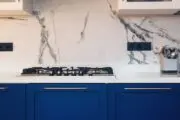With the emergence of generative AI as an interior design tool, the concept of a “dream home” has a whole new meaning. If you can imagine it – and describe it – you can watch the images in your mind come to life on a screen (with the correct guidance from textual prompts).
It could completely change how new homes are built, with homeowners having a much better idea of what the finished product could look like before the first nail is hammered.
Generative AI is a helpful tool in sparking inspiration. It’s like a fast pass for ideation, which is enormously beneficial in being able to communicate ideas and narrow down aesthetics, as well as help homeowners eliminate what they don’t like, along with being able to accurately name what they do like, in general terms.
There are several generative AI offerings available, but one that is gaining traction in the interior design industry because of its ability to produce detailed, stunning design images is Midjourney.
Accessing Midjourney through Discord, design-curious homeowners and designers input textual prompts, beginning aptly with /imagine. Midjourney then works through algorithms to produce stylized rooms with detailed design. It’s used in several segments of the art and design world but has practical applications in interior design and architecture.
Benefits of Midjourney for creativity and communication
“For designers, this is a form of ideation for them that is very, very quick and can help them get to a concept quickly,” Leslie Carothers, principal and a founder of Texas-based Savour Partnership, told Livabl.
Conversely, being able to arrive expeditiously at a concept that turns out to be unsuitable means that the process of elimination is more efficient.
Midjourney is a great place to create a mood board, which is often inspiration headquarters when beginning a project and trying to tie designs together.
Midjourney serves best as an initial planning tool, used early in the process between designer and client, to strike common ground in understanding objectives.
“You can enter information to come up with, not the final concept, but generate some initial ideas based on what the homeowner says,” says Carothers.
In that regard, Midjourney is also a great communication tool for designers and homeowners to understand each other in a space where language may not accurately represent ideas, or homeowners may need more language to describe the aesthetic they are ultimately after.
“Homeowners may not know the language of design,” says Carothers.
Concepts can be demonstrated based on what homeowners initially said they wanted. And then both the designer and the client can quickly find out if they’re on the same page or not, she says.
Using Midjourney
Conceptually, Midjourney is cool. With a few simple text prompts, your dream room will materialize in moments.
With Midjourney, the room being designed is done in its entirety, and there is no option to single out a design or décor element, which is one of the reasons that it is best suited as a method of trying out different overall aesthetics. If the goal is to zero in on specific elements, homeowners and designers might be better served using augmented reality AI, where they can layer the items in a particular room for design context.
Commands must be given with an /imagine prompt, and from there, you describe a design you’d like to see. By default, images are square, but you can alter the detail and appearance by changing the aspect ratio and other parameters.
A selection of images is generated based on the prompts. Midjourney also offers the chance to modify images based on the original prompts by selecting variations. This introduces subtle changes to the original image, which could mean slightly altering colors, finishes, etc.
For example, I created this design with the prompt: /imagine a farmhouse-style kitchen with island black fixtures, wood floor two, tone cabinet, large windows, and natural light.
And Midjourney offered these variations on the initial design.
Like with other generative AI, the result is only as effective as the textual prompts. Stick with short, detailed, simple instructions to get the best results.
Midjourney is available on a monthly subscription basis. You must have a Discord account, from which you can access Midjourney and join communities and channels to share and discuss creations.
The pitfalls of Midjourney
Using AI for interior design has its drawbacks and its critics, citing problems with copyright (a grey area, but Midjourney images can be re-used by community members commercially and can’t currently be copyrighted).
One of the biggest challenges for the designer/homeowner relationship, ironically, centers on Midjourney’s wide-reaching creativity and ability to generate unique designs.
Imagine sitting down for a brainstorming session with your designer, and together you formulate prompts, and Midjourney creates your ideal design, complete with the perfect furniture, accents, and color scheme.
While homeowners may be ready to replicate the room that has inspired them, it’s not as simple as purchasing what they see. That’s because the designs don’t exist in the physical world.
The upside is that homeowners can more clearly articulate their aesthetic, and they can take their time and buy what they love, hunting for similar items to create the same look. Or, if homeowners have the budget and the time, customization is an option.
That’s not to deter use but rather to temper expectations.
And homeowners should know that, although Midjourney is easy to use and is unexpectedly vivid and detailed in its designs, the ability to describe a room through text prompts does not make you a designer.
AI doesn’t replace an interior designer’s skill, experience, project management, and advisory value. What it does is facilitate ideation and lend speed and efficiency to the ideation process by contextualizing ideas with visuals.
Furthermore, Midjourney focuses on designing a single room at a time. One of the core benefits of working with a designer is their holistic approach to design, where each room and design element should ultimately be in place cohesively, even if a homeowner is only doing one room at a time in a remodeling or renovation project.
Similarly, while the images are inspiring, Midjourney does not consider the physical space and the influences around it, whereas a designer or architect would. Designers consider “the architectural envelope of the space, the materiality of the space, the protection of the space, as well as the landscape of the real design,” says Carothers.








